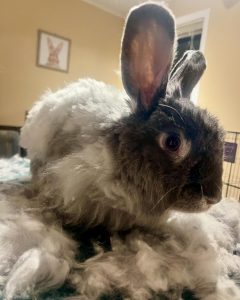
MOLTING / MOULTING
Molting is natural. It is when the rabbit’s fur is shed and replaced with new fur. In adult rabbits it typically happens in Spring and Fall. Some breeds molt more noticeably than others, and you may notice some smaller molting at other times of the year. Rabbits under 1 year old will molt around 5-6 weeks old and again around 4-5 months old.
BRUSH YOUR RABBIT
Help your rabbit from ingesting too much fur by gently brushing your rabbit. Hair that is ready to come out can also be gently pulled out.
Our favorites: Buster Comb (seen above) and a Small Comb *plastic tips*
Exception: Angora wool grooming should be done with a blowing technique rather than regular combing. Combs can cause breakage in the wool that can lead to more matting of the fur. This can be done with a gentle vacuum or a hair dryer (avoid overheating the rabbit).
RISKS OF MOLTING
For some, heavy molting can be taxing and cause the rabbit to not want to eat as much as usual. It is very important to prevent GI stasis during this by monitoring poops as well as food and water intake. Act quickly if noticing changes. GI stasis kills many rabbits daily, and it happens fast.
Ingested hair can clog the stomach or intestines by creating a hard ball called trichobezoar. We must be aware that the rabbit can not vomit, so it cannot expel the ball of hair. The acidity of the stomach is not great enough to disintegrate it. We must stop it from happening and act quickly if it does happen.
The observation of poop is very important:![]() If they are connected together forming a kind of rosary, you must be vigilant.
If they are connected together forming a kind of rosary, you must be vigilant.![]() If the size of the droppings gradually decreases you must be vigilant.
If the size of the droppings gradually decreases you must be vigilant.![]() If your rabbit does not want to eat anymore!
If your rabbit does not want to eat anymore!![]() If your rabbit makes a ball in a corner, or other signs of pain, CAUTION
If your rabbit makes a ball in a corner, or other signs of pain, CAUTION
WHEN IN DOUBT, GET HELP!
![]() ACT FAST – with a rabbit you have to act very fast when there is a concern. You must have an emergency rabbit savvy vet plan and an emergency kit (see here for a DIY kit).
ACT FAST – with a rabbit you have to act very fast when there is a concern. You must have an emergency rabbit savvy vet plan and an emergency kit (see here for a DIY kit).
A list of some rabbit savvy vets can be found HERE
PREVENTION OF BLOCKAGES![]() Brush and monitor your rabbit
Brush and monitor your rabbit![]() Feed a diet rich in fiber (Timothy hay) – hay stimulates the gut to work and keep food moving – HAY, HAY, & more HAY
Feed a diet rich in fiber (Timothy hay) – hay stimulates the gut to work and keep food moving – HAY, HAY, & more HAY![]() Feed appropriate amounts of vegetables that increase hydration (e.g., romaine lettuce, cilantro)
Feed appropriate amounts of vegetables that increase hydration (e.g., romaine lettuce, cilantro)![]() Water bowls (NO bottles)
Water bowls (NO bottles)![]() Daily exercise outside of an enclosure helps stimulate the gut
Daily exercise outside of an enclosure helps stimulate the gut
